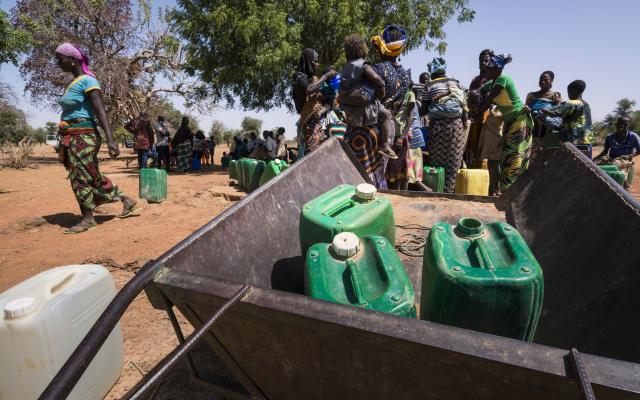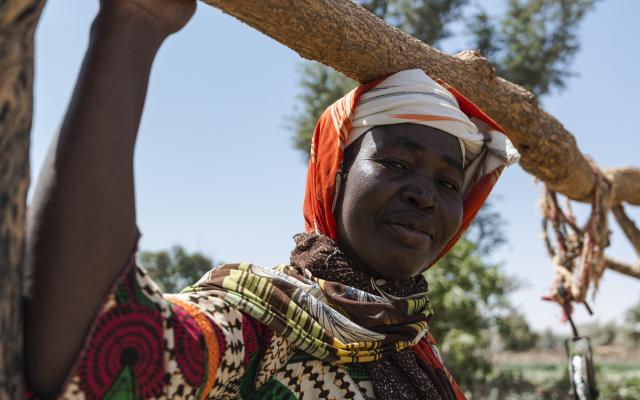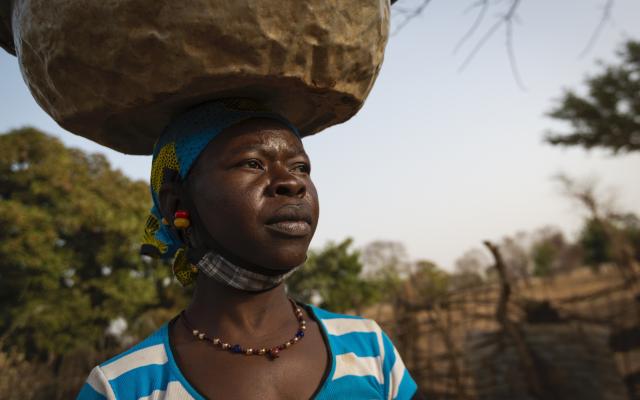
To cope with climate change and water scarcity, the people of Burkina Faso are being resourceful. Yet, alone, they cannot solve this global issue.
Since January 2019, the Northern Region of Burkina Faso has been affected by armed conflicts that have forced 1.7 million people to leave everything behind with the hopes of finding refuge in safer areas. As they turn their backs on conflict, they face a new challenge : finding water. To fully grasp the extent of this challenge, photojournalist Samuel Turpin travelled to the Central North region of the country with Oxfam, where water has become a scarce resource.
“My harvests are decreasing and I can no longer feed my family all year round”
It's early in the morning and we are standing around the water pump of the city of Kaya. The sun is already blazing down on the long queue, which is growing by the minute. Girls, women and children all wait in line hoping to fill at least one water jug - enough for them to cook, bathe or water their vegetables. And with each passing minute, the hope of getting water fades away a little bit more.


The population of Kaya, in the Central North region, has nearly doubled in two years with the arrival of hundreds of thousands of internally displaced people (IDP). This inflow of people has increased the demand for water and the city's water system is no longer able to accommodate everyone.
But the arrival of IDPs does not solely explain the water scarcity in this part of Burkina Faso. For some thirty years now, water sources have been drying up due to rising temperatures and insufficient rainfall.

Alizeta is a farmer, widow and mother of eight children living in the village of Louda.
“I have been farming all my life. I used to grow cereals,” she recalls. “But the crops are getting smaller and smaller. There is very little rainfall, and the dry season is getting longer and hotter.”
Like most people in Burkina, Alizeta relies on farming to provide for her family. With no water, her sole source of income is threatened.


In Namasigui, the situation is quite similar.
“Today, my main concern is water. The rainfalls are often insufficient. We now need to travel three kilometres to fetch water from the well,” explains Inoussa, a local farmer. “My harvests are decreasing, and I can no longer feed my family all year round.”


To cope with the effects of climate change, these farmers have reverted to more traditional farming techniques. “I use the method of half-moons and stone barriers to retain water on my fields. This slows down the water loss and evaporation,” explains Inoussa.

Not too far from there, in Soubo, Aguiratou has also had to use different techniques and diversify her activities.
“I learned how to use compost to fertilize the soils, how to build stone barriers to retain water in the fields during the rainy season, and how to prevent rainwater from leaching the soils.”
She was able to increase her harvest and stock up on food for the next lean season. It is the time, usually from May until September, when previous crops are used up and just before the first harvest of the year. This is the time when people are mostly food insecure.


Unfortunately, not all farmers in Burkina Faso will be as fortunate as Aguiratou. In 2022, we estimate that 33 million people in West Africa could face a food and nutrition crisis during the lean season, due to erratic weather conditions and continued conflicts.

One drop in an ocean of climate injustice
To cope with climate change and water scarcity, the people of Burkina Faso are being resourceful. Yet, alone, they cannot solve this global issue.
Our region is suffering the consequences of actions and inactions that are mostly the responsibility of rich countries. For example, Sahelian countries are responsible for a tiny share of global greenhouse gas emissions, estimated at 0.92%. Yet, Sahelian countries rank among the 20% of countries most vulnerable to climate change in the world, with Niger considered the most vulnerable.
It is time for leaders of West African states to pursue climate justice by demanding concrete actions from the leading polluter.
Photo credit: Samuel Turpin